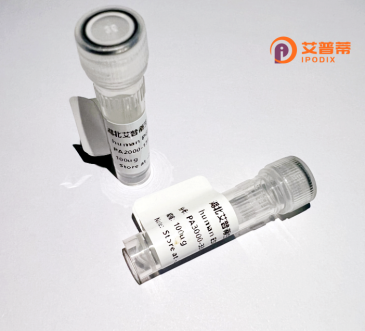
| 纯度 | >90%SDS-PAGE. |
| 种属 | Human |
| 靶点 | ARID3B |
| Uniprot No | Q8IVW6 |
| 内毒素 | < 0.01EU/μg |
| 表达宿主 | E.coli |
| 表达区间 | 1-561aa |
| 氨基酸序列 | MEPLQQQQQQ QQQQQKQPHL APLQMDAREK QGQQMREAQF LYAQKLVTQP TLLSATAGRP SGSTPLGPLA RVPPTAAVAQ VFERGNMNSE PEEEDGGLED EDGDDEVAEV AEKETQAASK YFHVQKVARQ DPRVAPMSNL LPAPGLPPHG QQAKEDHTKD ASKASPSVST AGQPNWNLDE QLKQNGGLAW SDDADGGRGR EISRDFAKLY ELDGDPERKE FLDDLFVFMQ KRGTPINRIP IMAKQILDLY MLYKLVTEKG GLVEIINKKI WREITKGLNL PTSITSAAFT LRTQYMKYLY AYECEKKALS SPAELQAAID GNRREGRRPS YSSSLFGYSP AAATAAAAAG APALLSPPKI RFPILGLGSS SGTNTSSPRI SPATTLRKGD GAPVTTVPVP NRLAVPVTLA SQQAGTRTAA LEQLRERLES GEPAEKKASR LSEEEQRLVQ QAFQRNFFSM ARQLPMKIRI NGRAEDRAEA SAAALNLTTS SIGSINMSVD IDGTTYAGVL FAQKPVVHLI TGSAPQSLGS SASSSSSSHC SPSPTSSRGT PSAEPSTSWS L |
| 分子量 | 60 kDa |
| 蛋白标签 | His tag N-Terminus |
| 缓冲液 | 冻干粉 |
| 稳定性 & 储存条件 | Lyophilized protein should be stored at ≤ -20°C, stable for one year after receipt. Reconstituted protein solution can be stored at 2-8°C for 2-7 days. Aliquots of reconstituted samples are stable at ≤ -20°C for 3 months. |
| 复溶 | Always centrifuge tubes before opening.Do not mix by vortex or pipetting. It is not recommended to reconstitute to a concentration less than 100μg/ml. Dissolve the lyophilized protein in distilled water. Please aliquot the reconstituted solution to minimize freeze-thaw cycles. |
以下是关于ARID3B的3篇代表性文献简要汇总:
---
1. **文献名称**:*ARID3B promotes ovarian cancer cell proliferation and metastasis via transcriptional repression of IRF1*
**作者**:Li et al., 2020
**摘要**:该研究揭示了ARID3B在卵巢癌中通过抑制干扰素调节因子1(IRF1)表达,促进癌细胞增殖和转移的分子机制。ARID3B高表达与患者预后不良显著相关。
---
2. **文献名称**:*Essential role of ARID3B in early embryonic development and maintenance of pluripotency*
**作者**:Suzuki et al., 2017
**摘要**:通过基因敲除实验,发现ARID3B是小鼠胚胎发育必需蛋白,参与维持胚胎干细胞多能性,并调控中胚层分化相关基因的染色质开放状态。
---
3. **文献名称**:*ARID3B interacts with E2F2 to activate pro-tumorigenic genes in hepatocellular carcinoma*
**作者**:Wang et al., 2021
**摘要**:研究报道ARID3B与转录因子E2F2协同作用,激活肝癌中促血管生成基因(如VEGFA)的表达,促进肿瘤微环境重塑和肝癌进展。
---
如需更多文献或研究细节,可补充具体研究方向进一步筛选。
ARID3B (AT-rich interaction domain 3B) is a member of the ARID family of DNA-binding proteins, characterized by a conserved ARID domain that recognizes and binds to AT-rich sequences in gene promoters. It functions as a transcription regulator, influencing cell proliferation, differentiation, and apoptosis. ARID3B is implicated in embryonic development, particularly in tissue morphogenesis and stem cell maintenance. Dysregulation of ARID3B has been linked to cancer progression, where its overexpression is associated with tumor growth, metastasis, and poor prognosis in cancers like breast, lung, and ovarian carcinoma. Mechanistically, ARID3B interacts with chromatin remodelers and transcriptional complexes to modulate target gene expression. Recombinant human ARID3B protein is used in research to study its DNA-binding properties, protein interactions, and role in oncogenic pathways. Studies also explore its potential as a therapeutic target or biomarker. Despite its established role in development and disease, full mechanistic insights into its context-dependent regulatory networks remain under investigation.
×